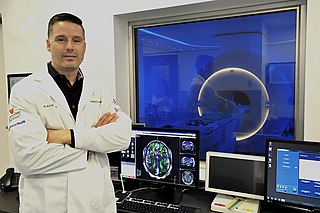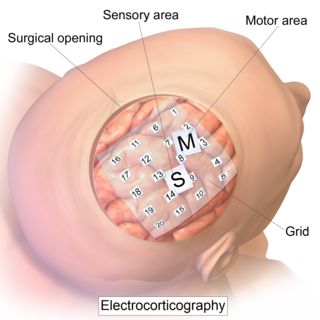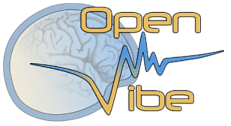 W
WBCI2000 is a software suite for brain-computer interface research. It is commonly used for data acquisition, stimulus presentation, and brain monitoring applications. BCI2000 supports a variety of data acquisition systems, brain signals, and study/feedback paradigms. During operation, BCI2000 stores data in a common format, along with all relevant event markers and information about system configuration. BCI2000 also includes several tools for data import/conversion and export facilities into ASCII.
 W
WBrain implants, often referred to as neural implants, are technological devices that connect directly to a biological subject's brain – usually placed on the surface of the brain, or attached to the brain's cortex. A common purpose of modern brain implants and the focus of much current research is establishing a biomedical prosthesis circumventing areas in the brain that have become dysfunctional after a stroke or other head injuries. This includes sensory substitution, e.g., in vision. Other brain implants are used in animal experiments simply to record brain activity for scientific reasons. Some brain implants involve creating interfaces between neural systems and computer chips. This work is part of a wider research field called brain–computer interfaces.
 W
WCyberkinetics is an American company with roots tied to the University of Utah. It was co-founded by John Donoghue, Mijail Serruya, Gerhard Friehs of Brown University, and Nicho Hatsopoulos of the University of Chicago. The Braingate technology and related Cyberkinetic’s assets were acquired by BrainGate in 2008. BrainGate, Inc. is a privately held company that holds technology that can help transform thoughts into action.
 W
WRyan C.N. D'Arcy is a Canadian neuroscientist, researcher, innovator and entrepreneur. D'Arcy co-founded HealthTech Connex Inc. and serves as President and Chief Scientific Officer. HealthTech Connex translates neuroscience advances into health technology breakthroughs. D'Arcy is most known for coining the term "brain vital signs" and for leading the research and development of the brain vital signs framework.
 W
WEar-EEG is a method for measuring dynamics of brain activity through the minute voltage changes observable on the skin, typically by placing electrodes on the scalp. In ear-EEG, the electrodes are exclusively placed in or around the outer ear, resulting in both a much greater invisibility and wearer mobility compared to full scalp electroencephalography (EEG), but also significantly reduced signal amplitude, as well as reduction in the number of brain regions in which activity can be measured. It may broadly be partitioned into two groups: those using electrode positions exclusively within the concha and ear canal, and those also placing electrodes close to the ear, usually hidden behind the ear lobe. Generally speaking, the first type will be the most invisible, but also offer the most challenging (noisy) signal. Ear-EEG is a good candidate for inclusion in a hearable device, however, due to the high complexity of ear-EEG sensors, this has not yet been done.
 W
WElectrical brain stimulation (EBS), also referred to as focal brain stimulation (FBS), is a form of electrotherapy and technique used in research and clinical neurobiology to stimulate a neuron or neural network in the brain through the direct or indirect excitation of its cell membrane by using an electric current. It is used for research or for therapeutic purposes.
 W
WElectrocorticography (ECoG), or intracranial electroencephalography (iEEG), is a type of electrophysiological monitoring that uses electrodes placed directly on the exposed surface of the brain to record electrical activity from the cerebral cortex. In contrast, conventional electroencephalography (EEG) electrodes monitor this activity from outside the skull. ECoG may be performed either in the operating room during surgery or outside of surgery. Because a craniotomy is required to implant the electrode grid, ECoG is an invasive procedure.
 W
WElectroencephalography (EEG) is a method to record an electrogram of the electrical activity on the scalp that has been shown to represent the macroscopic activity of the surface layer of the brain underneath. It is typically non-invasive, with the electrodes placed along the scalp. Electrocorticography, involving invasive electrodes, is sometimes called intracranial EEG.
 W
WEmotiv Systems is an Australian electronics innovation company developing technologies to evolve human computer interaction incorporating non-conscious cues into the human-computer dialog to emulate human to human interaction. Developing brain–computer interfaces (BCIs) based on electroencephalography (EEG) technology, Emotiv Systems produced the EPOC near headset, a peripheral targeting the gaming market for Windows, OS X and Linux platforms. The EPOC has 16 electrodes and was originally designed to work as a BCI input device.
 W
WMindball is created by the Swedish developer Interactive Productline IP AB.
 W
WEduardo Reck Miranda is a Brazilian composer of chamber and electroacoustic pieces but is most notable in the United Kingdom for his scientific research into computer music, particularly in the field of human-machine interfaces where brain waves will replace keyboards and voice commands to permit the disabled to express themselves musically.
 W
WNeuralink Corporation is a neurotechnology company developing implantable brain–machine interfaces (BMIs) and founded by Elon Musk and others. The company's headquarters is in the Pioneer Building in San Francisco sharing offices with OpenAI. Neuralink was launched in 2016 and was first publicly reported in March 2017.
 W
WThe neurotrophic electrode is an intracortical device designed to read the electrical signals that the brain uses to process information. It consists of a small, hollow glass cone attached to several electrically conductive gold wires. The term neurotrophic means "relating to the nutrition and maintenance of nerve tissue" and the device gets its name from the fact that it is coated with Matrigel and nerve growth factor to encourage the expansion of neurites through its tip. It was invented by neurologist Dr. Philip Kennedy and was successfully implanted for the first time in a human patient in 1996 by neurosurgeon Roy Bakay.
 W
WMiguel Ângelo Laporta Nicolelis, M.D., Ph.D., is a Brazilian scientist, physician and Duke School of Medicine Professor in Neuroscience at Duke University, best known for his pioneering work surrounding brain-machine interface technology.
 W
WOpenBCI is an open-source brain-computer interface platform, created by Joel Murphy and Conor Russomanno, after a successful Kickstarter campaign in late 2013.
 W
WOpenViBE is a software platform dedicated to designing, testing and using brain-computer interfaces. The package includes a Designer tool to create and run custom applications, along with several pre-configured and demo programs which are ready for use.
 W
WWireheading is a term associated with fictional or futuristic applications of brain stimulation reward, the act of directly triggering the brain's reward center by electrical stimulation of an inserted wire, for the purpose of 'short-circuiting' the brain's normal reward process and artificially inducing pleasure. Scientists have successfully performed brain stimulation reward on rats (1950s) and humans (1960s). This stimulation does not appear to lead to tolerance or satiation in the way that sex or drugs do. The term is sometimes associated with science fiction writer Larry Niven, who used the term in his Known Space series. In the philosophy of artificial intelligence, the term is used to refer to AI systems that hack their own reward channel.